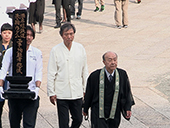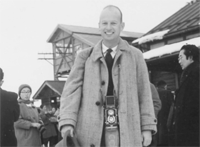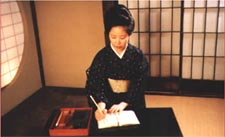 |
 |
MPG: Individual
Titles |
Follow links to order films
or contact us at (217) 333-9597 or aems@illinois.edu
for more information on obtaining DVDs.

|
NEW!
So Long Asleep: Waking the Ghosts of a War (2016, 60 minutes)
So Long Asleep: Waking the Ghosts of a War chronicles a decades-long project to excavate and repatriate the remains of Korean men who died doing forced labor in Hokkaido during the Asia-Pacific War. During WWII, “more than a million men were taken from Korea to labor at sites across Japanese and the South Pacific Islands; over 200,000 of them were sent to Hokkaido.â€(Byung-ho Chung) Many died in harsh conditions in the foreign land. In 2015, 70 years after the war’s end, a group of international volunteers, led by Japanese priest Yoshikiho and Korean scholar Byun-ho Chung, repatriated 115 victim remains to South Korea. The documentary raises important questions about war remembrance, reconciliation, repatriation, and international cooperation.
Educational DVD Available from DER. |

|
Can't Go Native?
(2011, 56 minutes)
In 1961 as a graduate student in anthropology, Iowa farm boy Keith Brown went to Northeastern Japan to gather data on Japanese kinship. Out of his total immersion in village life, and return visits just about every year since 1961, friendships and family-like bonds grew and developed over two generations. Can’t Go Native? is a portrait of Keith’s ongoing involvement in the evolution of a Japanese community, addressing the benefits of long term research as populations continue to age.
Official Website for Can't Go Native?
Available for online purchase through
CreateSpace.com |
|
 |
On Another Playground:
Japanese Popular Culture in America
(2008, 160 minutes)
First there was American-style "coca-colonization," now it's Soft Power: Japan's talent for infusing items from its modern popular culture into countries and lifestyles around the globe. A conference hosted by the American Studies program at Doshisha University in Kyoto explored recent trends in the spread of things Japanese into everyday life in the United States. Highlighting the conference were three detailed case studies presented by noted American anthropologists: Theodore Bestor (Harvard University) on sushi, William Kelly (Yale University) on baseball, and Christine Yano (University of Hawai'i, Manoa) on Hello Kitty. All three reports are now available on this DVD in the form of richly illustrated and professionally filmed public lectures.
Available for online purchase through
CreateSpace.com
|

|
Preaching
from Pictures: A Japanese Mandala
(2006, 37 minutes)
Preaching from Pictures takes viewers on a 37-minute tour through
the human life cycle and into the afterworld as depicted in an early-Edo
painting of the Jikkai Mandala. Versions of the Mandala were used
by nuns of the Kumano sect for many generations on their preaching
excursions around Japan. In order to provide historical context,
scenes from the Mandala are intercut with scenes from the Edozu
Byobu, a 17th century panorama of life in the capital city, with
commentary by Ronald P. Toby. The video was produced and edited
by David W. Plath, and is adapted from a program created by Japan's
National Museum of History and Folklore in Chiba.
Available for online purchase through
CreateSpace.com
|
|

|
Under Another Sun: Japanese in Singapor
(2001, 56 minutes)
Japanese as well as foreigners like to say that the Japanese are
an "Island People," uneasy about living overseas. But in today's
global era, sojourns abroad are becoming a normal part of life for
Japanese as for people elsewhere. Maybe the real displaced persons
in Japan today are those who have never lived under another sun?
A new documentary video program takes up that question. The program
is being created by the Media Production Group (our AEMS affiliate)
jointly with faculty from the Department of Japanese Studies, National
University of Singapore
Under Another Sun: Singapore's Japanese
is a one-hour program that explores the tensions people feel between
their attachments to their homeland and their desires to be freed
from the burdens imposed by living at home. Taking Singapore as
a case in point, the program profiles the activities of Japanese
sojourners from several walks of life. The program also reports
on shifts in the climate of sojourning across the 150-year history
of Japanese involvement in Singapore.
Online teacher's guide available here.
Available for online purchase through
CreateSpace.com
|
|

|
Makiko's New World
(1999, 57 minutes)
Early in the 20th century, new opportunities were opened to Japanese
women, thanks to modern consumer goods and to the new technologies
of self-awareness offered by snapshot cameras, family albums, and
mass-produced diary books. Nakako Makiko and her family were on
this hinge of historical change in 1910, the year that she kept
a daily record of her activities as the young wife in a busy merchant
household in Kyoto. MAKIKO'S NEW WORLD transports its viewers into
the almost-forgotten milieu of urban Japan a century ago. The program
blends historical photos and film footage with pictures from family
albums and with dramatized re-enactments of events Makiko recorded
in her diary. The program is suitable for classroom use in secondary
schools, colleges and universities, and for civic study groups.
Winner of the Silver Award in the 43rd Competition for Films and Videos on Japan 1999 (Sponsored by the Asahi Newspaper Corporation)
Educational DVD available from DER.
Activities for the High School Classroom.
Learning from Makiko: Background material, essays, and reviews
|

|
Barbarians: Fierce and Friendly
(1999, 15 minutes)
Historian Ronald P. Toby examines ways Japanese have expressed their understanding of the foreign as exemplified by Koreans, Okinawans, Chinese, and Americans both black and white. The program includes a rich array of drawings, paintings, and other visual images from eighteenth and nineteenth century Japan, showing aliens in popular art and aliens as enacted in festivals of the era.
Educational DVD available from DER.
|
|

|
Candles for New Years
(1992, 29 minutes)
For 200 years groups of Lahu have been migrating from southwestern
China into the highlands of Southeast Asia's 'Golden Triangle' region.
Though they share much with other migrants in the ethnic patchwork
of the region, the Lahu maintains a vigorous sense of themselves
as a distinct people. New Years is their prime time for celebrating
what it means to be Lahu. CANDLES FOR NEW YEARS is the first visual
portrait of Lahu life prepared for English-speaking viewers. Host
commentator for the program, anthropologist, Jacquetta Hill, has
followed for more than a decade the fate of a group of Lahu who
cleared the forest and built a community on a site north of Chiang
Mai. CANDLES FOR NEW YEARS was designed and directed by David W.
Plath and recorded on location in 1992. The program was produced
by a multicultural team of Lahu, Thai, Japanese and Americans.
Educational DVD available from DER.
|
|
 |
|
 |

